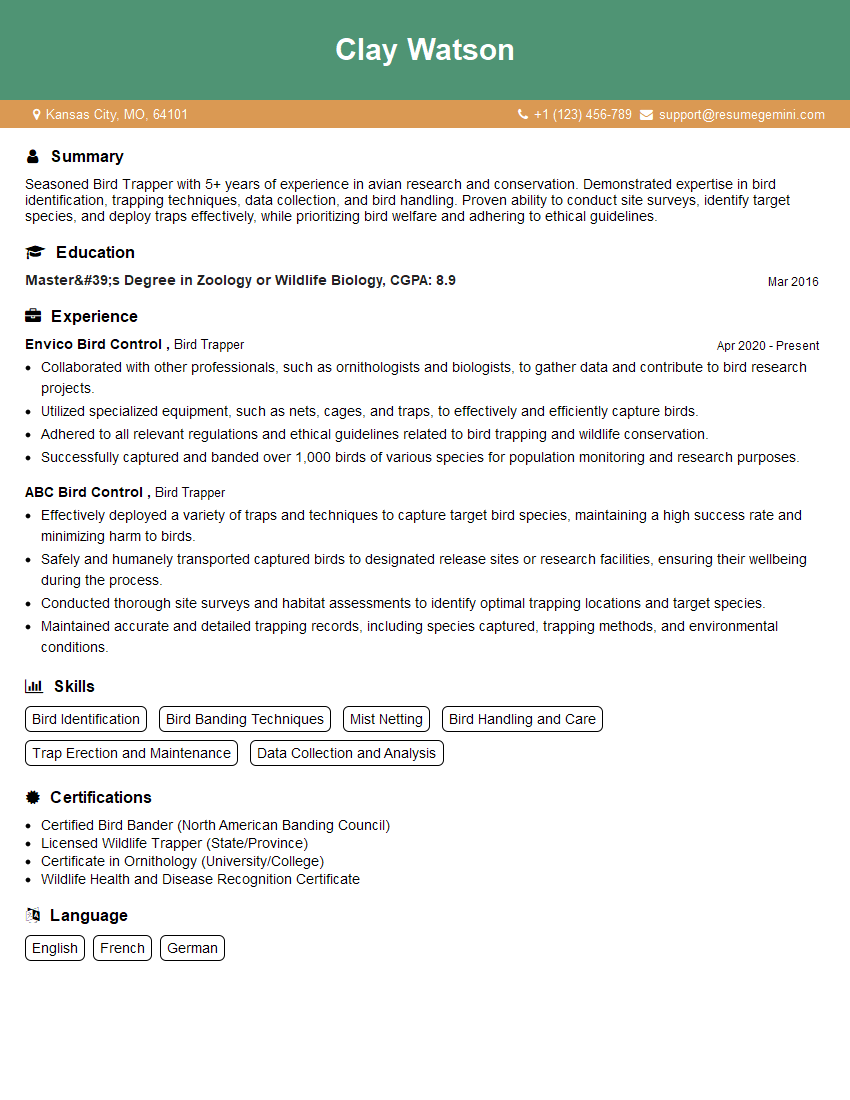Are you a seasoned Bird Trapper seeking a new career path? Discover our professionally built Bird Trapper Resume Template. This time-saving tool provides a solid foundation for your job search. Simply click “Edit Resume” to customize it with your unique experiences and achievements. Customize fonts and colors to match your personal style and increase your chances of landing your dream job. Explore more Resume Templates for additional options.

Clay Watson
Bird Trapper
Summary
Seasoned Bird Trapper with 5+ years of experience in avian research and conservation. Demonstrated expertise in bird identification, trapping techniques, data collection, and bird handling. Proven ability to conduct site surveys, identify target species, and deploy traps effectively, while prioritizing bird welfare and adhering to ethical guidelines.
Education
Master's Degree in Zoology or Wildlife Biology
March 2016
Skills
- Bird Identification
- Bird Banding Techniques
- Mist Netting
- Bird Handling and Care
- Trap Erection and Maintenance
- Data Collection and Analysis
Work Experience
Bird Trapper
- Collaborated with other professionals, such as ornithologists and biologists, to gather data and contribute to bird research projects.
- Utilized specialized equipment, such as nets, cages, and traps, to effectively and efficiently capture birds.
- Adhered to all relevant regulations and ethical guidelines related to bird trapping and wildlife conservation.
- Successfully captured and banded over 1,000 birds of various species for population monitoring and research purposes.
Bird Trapper
- Effectively deployed a variety of traps and techniques to capture target bird species, maintaining a high success rate and minimizing harm to birds.
- Safely and humanely transported captured birds to designated release sites or research facilities, ensuring their wellbeing during the process.
- Conducted thorough site surveys and habitat assessments to identify optimal trapping locations and target species.
- Maintained accurate and detailed trapping records, including species captured, trapping methods, and environmental conditions.
Certificates
- Certified Bird Bander (North American Banding Council)
- Licensed Wildlife Trapper (State/Province)
- Certificate in Ornithology (University/College)
- Wildlife Health and Disease Recognition Certificate
Languages
- English
- French
- German
Career Expert Tips:
- Select the ideal resume template to showcase your professional experience effectively.
- Master the art of resume writing to highlight your unique qualifications and achievements.
- Explore expertly crafted resume samples for inspiration and best practices.
- Build your best resume for free this new year with ResumeGemini. Enjoy exclusive discounts on ATS optimized resume templates.
How To Write Resume For Bird Trapper
- Highlight your expertise in bird identification and trapping techniques, including mist netting, banding, and other methods.
- Emphasize your experience in data collection, analysis, and reporting, showcasing your ability to contribute to research projects.
- Showcase your understanding of bird behavior, ecology, and conservation principles, demonstrating your commitment to ethical practices.
- Include relevant certifications, such as those in bird banding or wildlife handling, to enhance your credibility.
Essential Experience Highlights for a Strong Bird Trapper Resume
- Deployed a variety of traps and techniques to capture target bird species, maintaining a high success rate while minimizing harm to the birds.
- Safely and humanely transported captured birds to designated release sites or research facilities, ensuring their well-being during the process.
- Conducted thorough site surveys and habitat assessments to identify optimal trapping locations and target species.
- Maintained accurate and detailed trapping records, including species captured, trapping methods, and environmental conditions.
- Collaborated with other professionals, such as ornithologists and biologists, to gather data and contribute to bird research projects.
- Utilized specialized equipment, such as nets, cages, and traps, to effectively and efficiently capture birds.
Frequently Asked Questions (FAQ’s) For Bird Trapper
What are the key skills required to be a successful Bird Trapper?
A successful Bird Trapper requires expertise in bird identification, trapping techniques, data collection, and bird handling. They should also have a strong understanding of bird behavior, ecology, and conservation principles.
What are the different types of traps used by Bird Trappers?
Bird Trappers use a variety of traps, including mist nets, cage traps, and walk-in traps. The choice of trap depends on the target species, the habitat, and the desired outcome.
How do Bird Trappers ensure the safety and well-being of captured birds?
Bird Trappers prioritize the safety and well-being of captured birds by using humane trapping techniques, minimizing handling time, and ensuring proper transportation to release sites or research facilities.
What are the ethical considerations in bird trapping?
Bird trapping must adhere to strict ethical guidelines to minimize harm to birds and their habitats. Trappers must obtain necessary permits, follow approved protocols, and prioritize the welfare of the birds throughout the process.
How do Bird Trappers contribute to bird research and conservation?
Bird Trappers play a crucial role in bird research and conservation by providing data on population dynamics, migration patterns, and habitat use. Their findings inform conservation strategies and contribute to the protection of bird species.
What career opportunities are available for Bird Trappers?
Bird Trappers can find employment in various fields, including wildlife management, ornithology, environmental consulting, and bird conservation organizations.